The Maldives is not all about private islands and plush resorts that you would have to pay top dollar for. If you spent some time in Malé – capital city of The Maldives, you would realize that budget holidays are not impossible here. There are many places to visit in Malé that are both enriching and entertaining. Here is the lowdown on all that you can see.
Rasrani Bageecha (Sultan Park)

For MVR 75 per person (for expats and foreigners above the age of 18 only – Maldivian citizens enter for free), Rasrani Bageecha is one of the unmissable sights in Malé. While this public garden was formerly known as Sultan Park, the word ‘bageecha’ itself means garden. Ideal for all age groups, Rasrani Bageecha has about 18,000 trees in its complex.
Historically, this site dates back to the 16th century A.D. when The Maldives was a monarchy, ruled by a king. Sultan Park was a part of the grand royal complex. Later, when the monarchy came to an end and the country became a republic, most parts of the royal buildings were brought down. The park was renamed to ‘Rasrani Bageecha’ quite recently as it also saw a lot of renovation to modernize the park.
Children will particularly enjoy their time in this garden as they walk on the elevated wooden deck and glimpse all of Rasrani Bageecha from a vantage point. A green tunnel is another attraction that will hold the interest of kids. Playtime is so much fun when there is also a tree-house made of glass!
Topping the list of things to do in Maldives with family, Rasrani Bageecha offers a location that will relax the elderly members of your group as well. Meet and share stories at the mariyaadhuge (a traditional Maldivian pavilion) or rest on the benches when tired of strolling around. The youth would certainly appreciate the vertical garden, the hammocks to laze on, and a fountain with multiple storeys.
National Museum, Malé
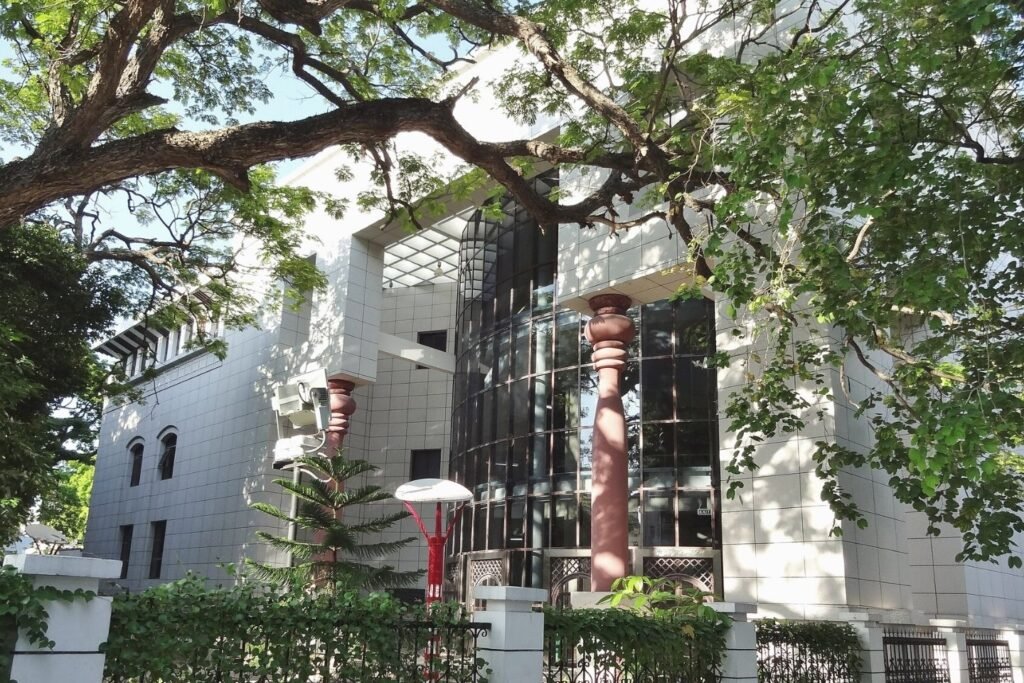
Whether you choose this option as part of one of Maldives’ full day tours or stop by independently, the National Museum in Malé will definitely be worth your while. Located within the Sultan Park complex, the museum traces its roots back to 1952, a time when the country swung between a monarchy and a republican system of governance.
Established on the National Day of this archipelago – 11th November, the museum efficiently captures and displays Maldives’ history and culture. As part of the museum collection, visitors can see costumes, arms, coins, armoury, royal furniture, thrones and ornaments. Apart from these, even the walls have engravings from the Quran – all of them handwritten.
The National Museum is open on all days of the week except Fridays. One can visit between 10 AM and 4 PM. The museum has 3 storeys – all in the old building which was once a part of the Maldivian Royal Palace. Most of the ancient walls and buildings have been destroyed, but the National Museum remains.
Hukuru Miskiiy (Old Friday Mosque or Malé Friday Mosque)
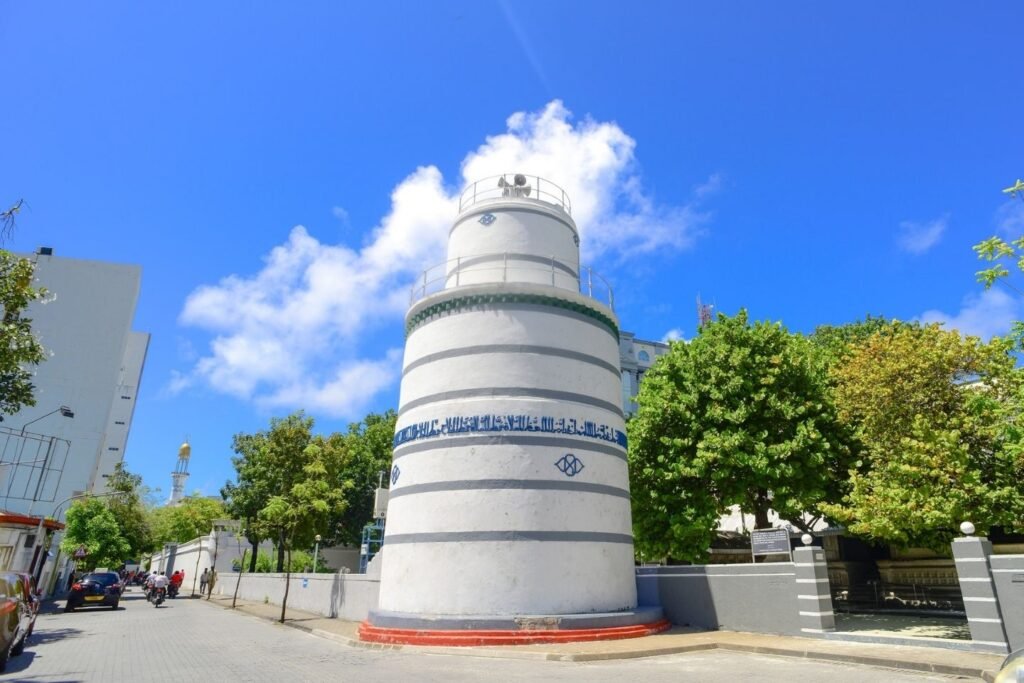
Popularly known as the Old Friday Mosque, Hukuru Miskiiy is an Islamic shrine. This architectural gem was built in 1658 with the use of Porites – white coral boulders, to be specific. Sometimes referred to as Malé Friday Mosque, architecture buffs must see this edifice only for the traditional Maldivian architecture that it flaunts.
One of the more well-paced activities to do in Maldives, touring Hukuru Miskiiy will offer you an unmatched insight into the spiritual lives of the common Maldivian. Friday prayers are held here every week when worshippers of Allah – the god of Islam, gather to read the namaz (texts from the Quran – revered as the holy book of Muslims).
Even the woodcarving specimens inside the shrine have Quranic inscriptions, reminding tourists that they are in a Muslim country. With the full feels of Mecca, the Old Friday Mosque has a minaret – quite similar to the one in Saudi Arabia. With a full capacity of 10,700 standing devotees, the Malé Friday Mosque happens to be the oldest Islamic house of prayer in The Maldives.
Mulee Aage
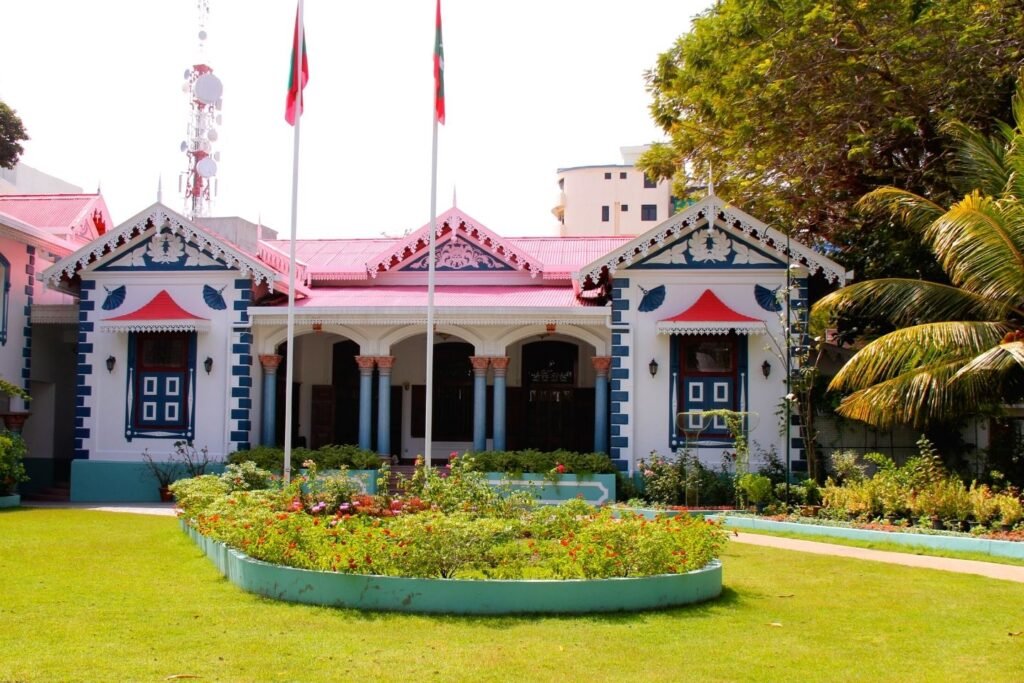
The official residence of the President of The Maldives, Mulee Aage was built in 1919. Sporting a colonial bungalow style of architecture, the building has a striking red roof and blue pillars, with accents on the walls in the same shade of blue. The Presidential Palace is located in the historic centre of Malé – the world’s smallest capital.
While this gated complex has been housing presidents of this island country for the past decade or so, this white façade was once the residence of the crown prince. Later, it was the location for the Ministry of Home Affairs. The official building has also been the Prime Minister’s office and the Supreme Court of The Maldives. Tourists are not allowed to enter the premises. However, it is possible to take pictures at the gate.
Tsunami Monument
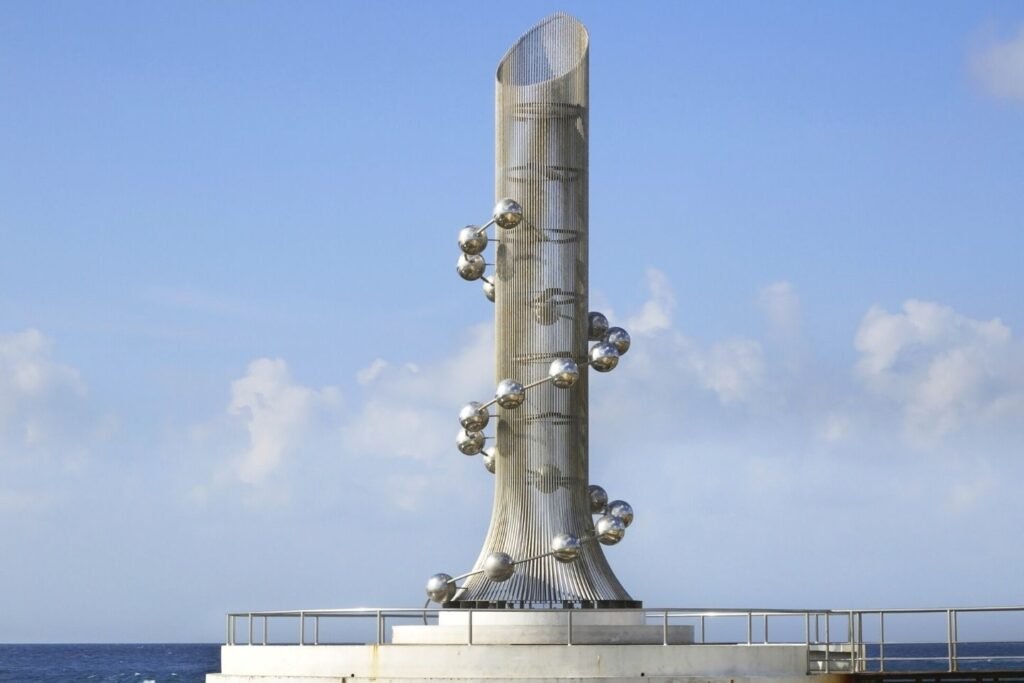
If you recall the devastating tsunami of December 2004 that wreaked havoc on most of the countries in The Indian Ocean, you will be better able to appreciate the Tsunami Monument. Located in Thin Ruh Park on Boduthakurufaanu Magu, this memorial is made of steel, with a set of spheres that are affixed in a spiral formation around the central structure.
Each of these shiny spheres is dedicated to the Maldivian citizens who lost their lives, property and livelihood in the horrific natural calamity. The Tsunami Monument is lit up in colourful lights when it gets dark, making it a glittering attraction for passersby.
The park that houses the Tsunami Monument is a small but neat one – nice for children to play and for adolescents to pose for photos on some of the larger spheres positioned for reflective photography and relaxation. The views of the sunset are also nice from here. If you are scheduled to catch a ferry to the nearby local island of Villimalé , the Tsunami Monument is right next to the ferry terminal!
Malé Fish Market
The local fish market of Malé is a place of much commotion and strong smells. Open on all days of the week, from 7 AM until 8 PM, Malé Fish Market is an open marketplace for freshly caught fish. It is customary for Maldivian fishermen to lay out all the day’s catch on the tiled floor of the market.
If you are not here to buy fish, there is still so much to photograph and experience. Check out the popular fishes such as tuna, mackerel and groupers. Other seafood such as lobster and different types of crustaceans also make their way into this fish market.
The action begins before you even enter the marketplace as you watch the hardworking fishermen lug in boxes of fish from their vibrantly painted boats into the marketplace. Sometimes, it requires two fishermen to carry just one fish – especially when it is a large trophy fish. The haggling and purchasing starts from outside itself.
Once inside, you can request the staff to cut your fish into fillets or however you wish to carry your purchase. Despite the hubbub and marine stench, you will like the cleanliness of Malé Fish Market. Explore the two distinct sections – one for whole fish and another for the processed version. The processing is very organized, with sorting bins for different fish, and personnel to remove the scales and clean up the innards of the fish before slicing them up.
Majeedhee Magu
Majeedhee Magu is not just an attraction but an entire street in Malé! Cutting the capital of The Maldives into two halves, this street is a part of most Malé City walking tours. Open to public from 9 AM until 11 PM, this shopping street is ideal for window shopping and purchasing souvenirs for your friends and family back home.
Majeedhee Magu is a pocket-friendly place where you can buy fashion accessories, colourful textiles, jewellery items such as bracelets, earrings, necklaces and bangles, cosmetic products, and also electronic gadgets. For those interested in the local outfit, called libaas, this street has several sellers. Check out assorted headgear and the traditional long dress. Bargaining is possible here, so there is a great chance of getting nice products for lower costs.
Artificial Beach
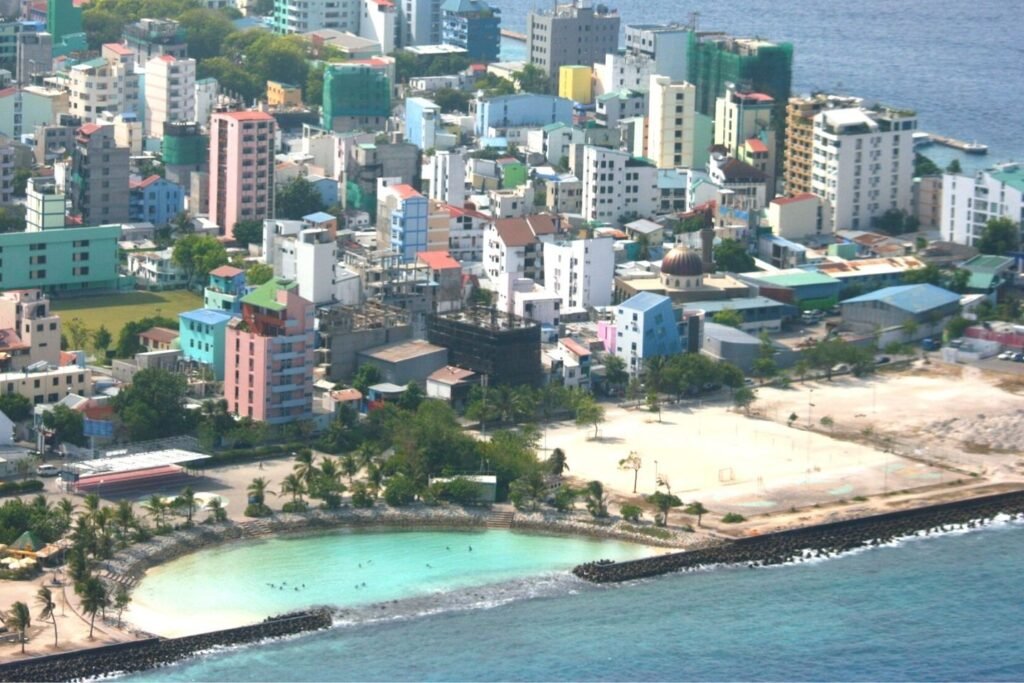
A popular hangout for the locals, Artificial Beach is a public beach in the capital city of The Maldives. This crescent-shaped beach offers a clear view of the SinaMalé Bridge, while also letting people watch aeroplanes land at the Velana International Airport in Hulhumalé.
A man made beach, here you will not only be able to swim but also walk or jog on the white sand. The seashore also has places to sit from where you can admire the tetrapods that protect the Artificial Beach from being eroded. The breakwater extends along the crescent shaped beach that is also considered safe for children to swim.
One must obey the local rule of appropriate beach attire as this is not a bikini beach, but a public one on an inhabited island. It is prohibited to wear short clothes, bikinis or walk shirtless so you do not hurt the sentiments of the locals who follow Islam.
Grand Friday Mosque or Masjid Al-Sultan Muhammad Thakurufaanu Al-Auzam
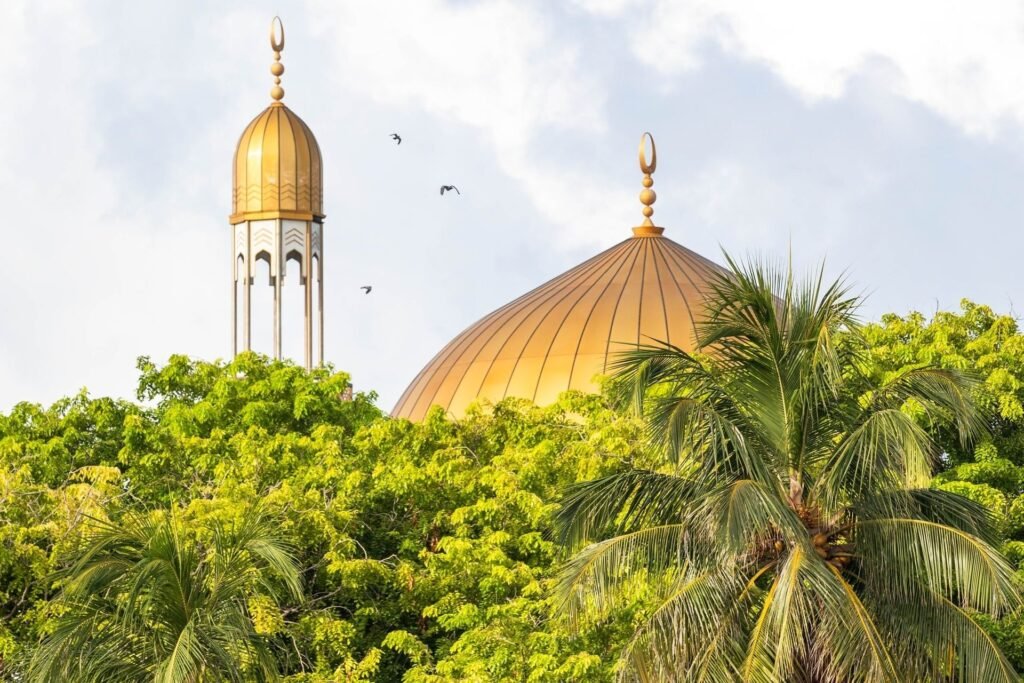
Officially known as Masjid Al-Sultan Muhammad Thakurufaanu Al-Auzam, the Grand Friday Mosque is on the itinerary of almost all walking tours in The Maldives. The largest Islamic shrine in the country, this building is rather simple in terms of architecture.
With a shiny golden dome and a gold-coloured minaret-top, the Grand Friday Mosque was erected to pay respect to a Maldivian hero named Sultan Muhammad Thakurufaanu Al Auzam who freed the country from Portuguese rule. The edifice is made of white marble and has carved wooden panels in its interior.
With a total seating capacity of 5,000, this mosque allows tourists to enter from 9 AM to 5 PM, only when the Islamic prayers are not underway. Admire the dazzling chandeliers that hang from the grand ceiling of this spacious mosque. Remember to dress conservatively, with your arms, legs and head covered.
Hulhumalé Beach

Located in the public island of Hulhumalé, this beach is the perfect place to catch the Maldivian sunrise. If you are looking for cheap hotels in Maldives, you will find plenty of options with a lovely sea view here. Foodies can also rejoice at the sight of numerous restaurants that make beachside dining a real treat.
Hulhumalé Beach is blessed with clear waters and powdery white sands. While taking a walk along the shore can be therapeutic, you can also indulge in an assortment of water sport activities such as surfing, kayaking and banana boat rides.
While one has to be conservatively clothed at most parts of this small beach, there is a bikini beach section at the Hulhumalé Beach where travellers are allowed to swim in their bikinis. This section is separated out of the rest of the stretch. Swimming is safe here as the water level is shallow.
SinaMalé Bridge
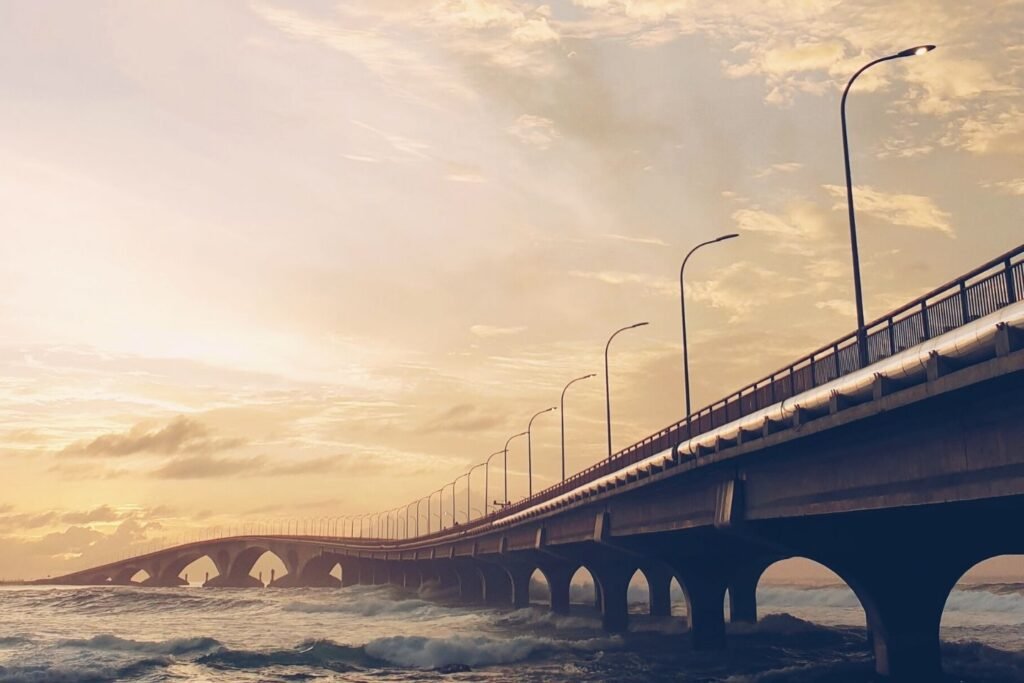
Stretching along 1.39 kilometres, the SinaMalé Bridge connects 3 of the public islands of Malé by road. Formerly called the China-Maldives Friendship Bridge, this structure connects the islands of Malé City, Hulhumalé and Hulhulé (which is home to Maldives International Airport).
Part of the Malé Metropolitan Area, the SinaMalé Bridge has a width of 20.3 metres. The bridge became functional in 2018, and has been very convenient for both pedestrians and vehicle owners ever since. There are dedicated lanes for cars, motorbikes and pedestrians on this bridge, making it safe to walk across as well.
The ideal way to enjoy the Sinamalé Bridge is to take a slow paced walk along the pedestrian lane and take photos of the views of the blue ocean and the islands on either ends. If you wish to see the bridge in its full glory, go around sunset so you can not only catch the sunset but also see the bridge lit up, gleaming against the Indian Ocean.
Medhu Ziyaaraiy Shrine
Sitting next to Mulee Aage, Medhu Ziyaaraiy is the tomb of Maulana Al-Hafiz Abul Barakaath Yoosuf Al-Barbari. The Maldives converted into Islam only through the influence of Abul Barakaath who was a Muslim preacher and had travelled here all the way from Morocco in the 12th century A.D.
Located at the centre of Malé, the shrine is white in colour. Medhu Ziyaaraiy literally translates to “central tomb” in Dhivehi – local language of The Maldives. The tomb of Abul Barakaath is venerated above all other tombs in the country.
While nobody is allowed to enter the building, this heritage site holds great significance for the people of The Maldives. Close to Medhu Ziyaaraiy, there another tomb belonging to Muhammad Thakurufaanu. Also known as Sultan Mohamed Shamsuddinul Hamavee, he was a 17th century ruler of this nation.
Republic Square
A tranquil open square in the heart of Malé City, Republic Square is more than just a landmark. In the congested landscape of Malé, this square is a breath of fresh air. With tree-lined sides and a peep into the ocean, this open square was once known as Jumhooree Maidhaan. Located close to Jetty No. 1, this public square is quite convenient to reach.
In Dhivehi, “maidhaan” means ground, referring to the open area. Apart from being a meeting place, Republic Square has a flag pole where the national flag of The Maldives is hoisted. In existence since 1989, the large space is often used to feed pigeons.
Republic Square also has a fountain that makes the place enjoyable for young children. Evening times are the best to be here as that is when the wind blows and makes the national flag flutter. Apart from that, it gets very pleasant around that time. You might also be able to watch the Defence march and take pictures and videos.
Villimalé Island (Villingili Island)
Villimalé, while being a part of Malé, is an island in itself. Formerly known as Villingili, this inhabited island is well connected to Malé City and Hulhumalé via ferry. From Malé City, one has to catch the ferry from jetty number 5 while from Hulhumalé, the main jetty offers ferries to Villimalé.
The public ferry gets you here in just 15 minutes. You can either check out this local island by yourself or sign up for the 4-hour Villimalé eco walking tour for a thorough exploration of this village. Once a resort island, Villimalé was later used as a prison island. However, in the past few years, it has become a public island, mainly used to relocate the overburdened Malé City.
There are plenty of Activities & Things to do in Villingili (Villimalé) Island. The 2 public beaches on Villimalé are ideal to soak in the Maldivian sun. Interact with the locals and understand how they work with an NGO to maintain the delicate balance between environment protection and development on this island.
You might be able to participate in a coral planting activity which will involve snorkelling or diving in the Indian Ocean and placing a healthy coral on an artificial grid to stimulate the natural reproduction of corals and improve the reef quality of this region. You will also be able to watch different types of hard and soft corals and fish as you make your way to the seabed.
Villimalé has an active hedika culture which means that the islanders take their tea and snacks between 3 PM and 5 PM, just before it is time for sunset. Join in the fun and sip on some kau sai (black tea in Dhivehi) at one of the idyllic beachfront cafés here. This beverage is had with some sweet or savoury deep-fried traditional snacks called hedika. You can also slouch on a jolie (unique Maldivian rope-woven chair seat – like a hammock in a chair form) as you watch the sunset.
Rasfannu Beach
One of the best beaches in Malé, Rasfannu Beach not only offers dazzling views of the ocean and the soft sands to walk on but also has plenty of activities one can enjoy. Try your hand at fishing or engage your family in a DIY barbecue with the salty wind blowing in your hair.
There is a jogging track on this beach – ideal for tourists who would like to catch up on their daily run. Fitness freaks can even use the open-air gym to squeeze some workout in their vacation. Besides, you can swim in the sea water. There are no changing rooms though. Bring a large blanket to create a makeshift tent for changing into your dry clothes.
If you get hungry after a lot of jogging or swimming at Rasfannu Beach, eat at the restaurant on the beach. For simply watching the sunset, slump into one of the jolies that are placed on the white sand. Made of a wooden frame and an interwoven rope seat, these traditional Maldivian chairs are fun to sit on.
Varunulaa Raalhugandu
The only surf spot in Malé City, Varunulaa Raalhugandu is a rocky beach, unlike most other beaches in the capital (which are sandy). The ocean waves that crash here are ideal for surfing, which is not possible on shallow sea beaches. The beach also offers a clear view of the Sinamalé Bridge.
With coarse sand particles and stones on the shoreline, Varunulaa Raalhugandu attracts surfers from all over the country and sometimes, even the world. Even if you are just training to become a surfer, the variety of wave conditions and wave types that hit the beach prepare you for different levels and types of surfing.
Other Prominent Places to Visit in Malé
This list of places to see in Malé is not exhaustive by any measure. After you leave Hulhulé Island, if time permits, you can explore Malé harbour, Masjid Al-Iskandar, Hulhumalé Central Park Leisure Zone (also known as Koimala Gardens), Raaveribey Maizaan and Friday Mosque of Hulhumalé.
If there are so many places to visit in Malé, can you imagine how much more you can see in this country of about 1,200 islands! Book your trip to The Maldives soon with Samudra Maldives to see paradise on earth.
